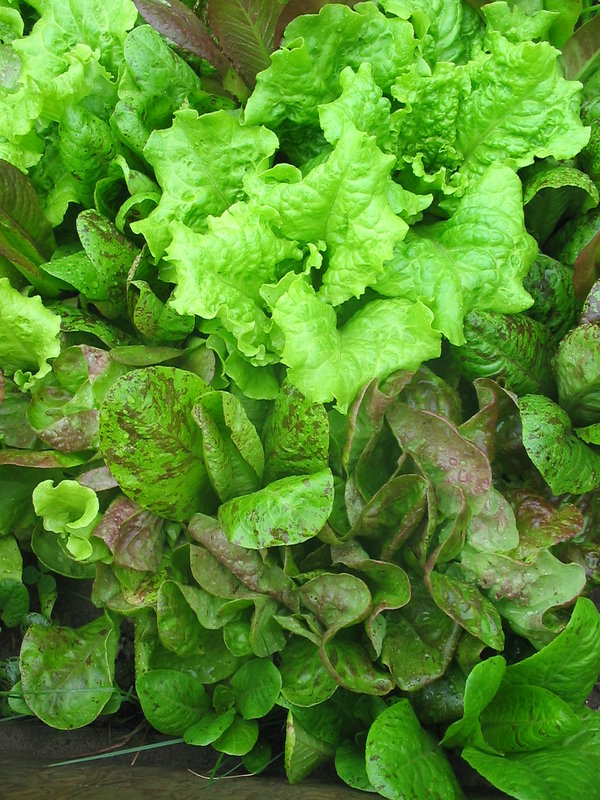Back to August 2015 Newsletter
How to Grow Autumn Vegetables

Bob Wildfong
When I started gardening, I was taught that you had to plant all your seeds during the long weekend in May. That made for a short lettuce season, and a shorter radish season. Beans all came at the same time, and there wasn't really much left in the garden by the end of summer. What I learned back then was wrong - don't do it.
Later I learned that some vegetables prefer cool weather, and they even tolerate some frost. Brassicas (like kale, cabbage, and kohlrabi) and peas can be sown as early in the spring as you can get the seeds in the ground. Root vegetables, such as beets and carrots, tolerate cool soil and cold air, so they can go in the garden about a month before the tomatoes and beans. You can plant most leafy greens, like lettuce and spinach, when only light frosts are likely, and you can keep sowing more of them to get a consistent harvest throughout most of the summer. The trouble is, once it gets too hot for seeds to sprout reliably, it gets more difficult to grow these cool-weather crops in mid-summer.
But even later, I learned that the fall is actually a really good time to grow "spring" vegetables. August weather is often a lot like June, except it gets chillier throughout the month instead of warmer. September is a lot like May, and so on, so with a little planning you can have spring all over again. The only differences are that it gets colder instead of warmer, and the days get shorter instead of longer, so your plants grow differently, and you have to rearrange all your instincts about timing.
To get a nice fall lettuce, for example, think about when you usually get a hard frost. Count backward according to the days to maturity for your variety, and then count backward another ten days. That's the last day in summer when you should sow those seeds. For instance, a 60 day lettuce should be sown no later than 70 days before the hard frost. Why do you add ten days? Because you're used to the plants growing faster in spring as the days get longer and the weather warms up, but in a fall planting the days will get shorter and the weather will cool down so the plants will take longer to mature.
Root vegetables and most greens can tolerate a light frost, and you've probably been amazed to see early spring sprouts survive unexpected frosts that turn your car windshield white. Mature greens manage frost too, but they can be more susceptible because they're further from the ground, so they don't benefit from the radiant warmth from your soil at midnight. If you hear of an autumn killer frost coming, throw a blanket over your veggies at night to keep them warm - in the spring you can always replant, but your fall harvest is your last chance of the season.
Depending on the varieties you choose, and your climate, you might find that the above calculation tells you to plant your fall seeds in the middle of summer heat. That probably won't work well. Seeds of cool-weather vegetables don't like to germinate in hot soil, and the seedlings obviously have tiny roots that won't reach deep enough to find moisture if the soil is dry. Here are two tips:
- Sow your fall crop seeds in flats indoors or in a shady place. You'd sow seeds indoors in the early spring to protect them from cold weather, so why not do the same thing to protect them from hot weather? You can also sow seeds in part shade, where the soil is moist and cool. Then transplant your seedlings to the garden when they get two true leaves. By that time, midsummer heat will be on the way out, the nights will be cooler, and transplanting will be easy.
- Choose short-season varieties. The quicker they mature, the later you can plant them before the hard frost, and that means you can plant the seeds in cooler soil. Instead of the 60 day lettuce, choose 50 day Lollo Rossa, 40 day Oakleaf, or the small but excellent 35-day heirloom lettuce Tom Thumb.
Water your seedlings well. Don't let them get hot and dry. You're used to caring for little seedlings when the weather is cool and moist in spring, but you have to get them started when it's hot instead. Many cool-weather plants, particularly cabbage and kale, but also root vegetables like carrots, will stop growing when they're too hot or dry. Any delayed growth during those periods means that they might not mature before the frost comes. The solution is to water, water, water until they get their first two true leaves.
The bonus of fall gardening is that the weeds slow down in late summer and basically stop growing in the fall, there's often no need to water the garden past Labour Day, and all your neighbours will be so amazed at your garden's bounty when you're still harvesting perfect lettuce, spinach, asian greens, baby beets, carrots, fresh kohlrabi, chard, radishes, and peas when they're already putting their gardens to bed for the winter.
**
Bob Wildfong is the executive director of Seeds of Diversity Canada.
Not yet a member?
An annual membership to Seeds of Diversity gives you access to our seed exchange, seed grow-out programs, and our online news.

We depend on donations to do our work.

Thank you for your support!
